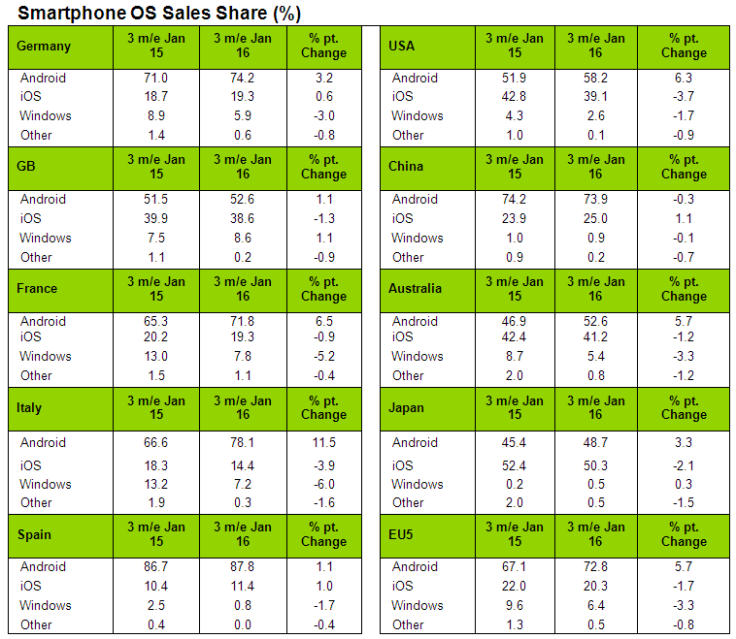Apple Inc. Faces iPhone Slowdown In China While Losing Ground To Android In US

Apple’s smartphone is showing some signs of weakness in China, one of the company's most important markets. In the three-month period ended Jan. 30, the iPhone continued to grow its share in China, but at the slowest rate since late 2014, according to Kantar Worldpanel ComTech.
The slowdown wasn't exclusive to China, as the iPhone maker also lost share in the U.S. to Android manufacturers, which accounted for over half of smartphones sold in the period.
Apple saw its share in China grow to 25 percent, a 1.1 percent increase over the same period in 2015. One reason for the slower growth is customers in China may have held out for iPhone promotions and deals during the Feb. 8 Lunar New Year. In the 2014 holiday period, Apple was fulfilling pent-up demand for iPhone 6.
Still, Apple maintained its lead as the top smartphone brand in China with the iPhone 6S, 6S Plus and iPhone 6 taking top spots. Trailing in second place was Android smartphone maker Huawei with 24.3 percent of sales during the period. Xiaomi was a distant third at 17.3 percent, down 10.2 percent compared to 2015.

In the U.S. market, Apple's share fell in the period to 39.1 percent, a 3.7 percent drop. Much of that loss was scooped up by Android, which grew its share to 58.2 percent, a 6.3 percent increase in the period.
Apple also lost out to Android manufacturers when it came to upgraders in the U.S. During the period, Android manufacturers saw a third of their sales coming from that segment, compared to 13.7 percent for iOS. The most popular Android brand purchased was Samsung, followed by LG, Motorola and budget brands such as Alcatel and ZTE.
The latter company is, at least for now, barred from buying U.S. components after the the Department of Commerce alleged it violated U.S. sanctions against selling certain technologies into Iran.
Upgraders have become an important market for smartphone manufacturers to target in 2016, as growth in the United States, China and Western Europe has slowed to single-digit rates, according to IDC.
Apple is stepping up its efforts in the United States to get its customers to upgrade more frequently. With the iPhone 6S launch in September 2015, Apple introduced an upgrade program that lets customers trade in their device to upgrade to the latest iPhone model after 12 monthly payments. In February, it expanded the plan, enabling customers to trade in older iPhones in exchange for a discount on monthly installments.
Samsung has also followed suit with an upgrade program of its own in the U.K., which allows customers to upgrade to a new Galaxy device on a yearly basis in exchange for monthly payments.
© Copyright IBTimes 2025. All rights reserved.



















